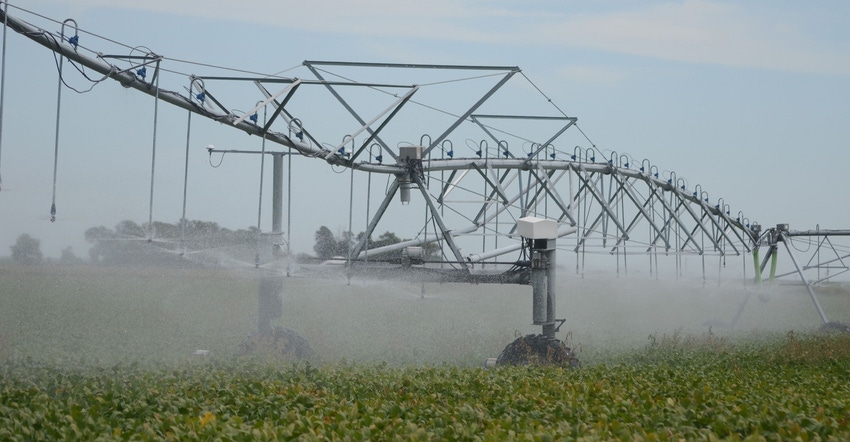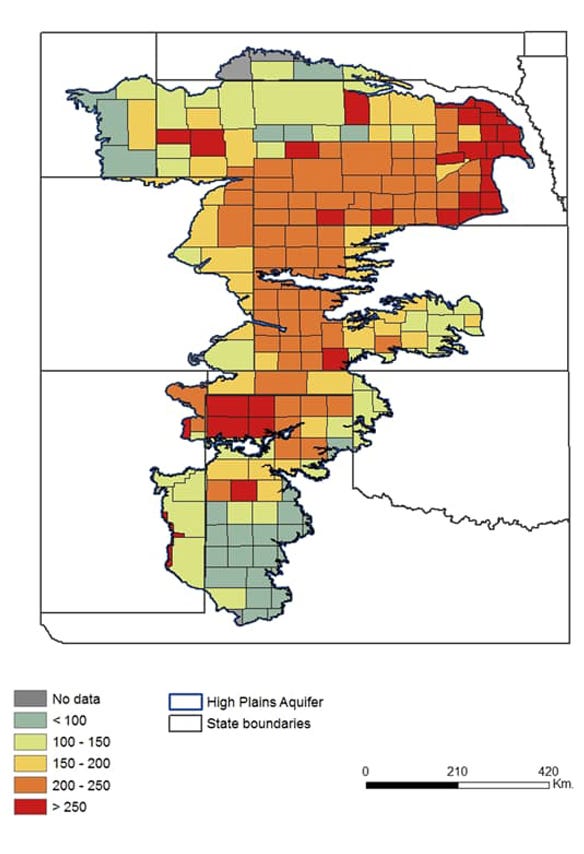November 30, 2018

Recent research finds the extra agricultural production from irrigation across the High Plains Aquifer was worth about $3.5 billion in 2007, $2 billion of which was produced in Nebraska. The research was conducted by the University of Nebraska-Lincoln Department of Agricultural Economics and the University of the Republic's School of Agronomy in Uruguay
The High Plains Aquifer underlies an area that includes southern South Dakota, southeast Wyoming, eastern Colorado, Nebraska, western Kansas, eastern New Mexico, northwest Oklahoma and northwest Texas. This region has a semiarid climate that makes crop production highly dependent on irrigation. While irrigation has resulted in severe depletion in some areas of the High Plains Aquifer, keep in mind the overall economic value of this resource in agricultural production.
The research analyzed crop production and weather information each year from 1960 to 2007 for each of the 205 counties overlying the High Plains Aquifer. The key parameter was the ratio of yields (total biomass per acre) on irrigated land compared to nonirrigated land (also known as the "IR elasticity"). IR elasticity averaged about 50% over the whole period but had increased to about 60% by 2007.
Estimates of IR elasticity were obtained using a regression technique that related observed county dry matter yields to the share of irrigated county area, the rate of fertilizer and chemical applications, and weather variables. The latter included growing-season precipitation and four "degree day" variables measuring the amount of time over the season the crop was exposed to various temperature ranges.
Table 1 illustrates how the estimated IR elasticity was converted into total value of production, summed across counties to state levels.
First, observed yields at the county level were multiplied by the IR elasticity estimate for the county to estimate the extra production due to irrigation. Next, that yield increment was multiplied by the average price for biomass in the county (the sum of all crop production in tons of total aboveground biomass produced, divided by total revenue from all crops). For this table, counties in each state were summed to obtain the total value by state for the year.

As Table 1 shows, Nebraska benefited most from water withdrawn for irrigation, with Kansas and Texas a distant second and third, respectively. Nebraska's estimated IR elasticity of 0.525 for 2007, applied against a yield of 4.856 tons of bone-dry biomass, implies that irrigation was responsible for an extra 2.55 tons per acre.
At an average price of $103.50 per ton, this indicates the average acre irrigated across Nebraska realized $264 per acre of additional production, or about $2 billion, when accounting for the 7.6 million acres irrigated.
Figure 1 illustrates the geographical distribution of county-level estimates of the value of extra production due to irrigation in 2007. The differences between counties are due in part to differences in estimated irrigation elasticity, in part to differences in yields on comparable nonirrigated land, and in part due to differences in the value of the extra biomass produced (the mix of crops differs considerably across the High Plains Aquifer).
The analysis also provided an estimate of the crop production damage caused by extreme temperatures — those above 91.4 degrees F. For each county and year, the number of hours over the growing season that the crop was exposed to this high temperature was calculated. The result was divided by 24 to convert it to degree days.
Figure 1. Estimated value of extra agricultural production due to irrigation over the High Plains Aquifer, 2007

Results indicated that each such degree day reduced yields by 3%. The average number of such degree days across the entire region and period was 2.7, indicating that, on average, extremely high temperatures decreased crop yields by about 8%. In Nebraska, the average number of 91.4-degree days was only 1.4, for a 4% loss. But in 2002, there were 2.8 of these degree days, causing a loss of about 8% of all agricultural production (USDA surveys showed yields to be about 10% below trend that year).
The Great Plains states, especially Nebraska, depend heavily on the contributions of water from the High Plains Aquifer to augment agricultural production. Nebraska overlies 36% of the total area of the aquifer and 69% of the total water volume. Water pumped for irrigation in Nebraska contributed about $2 billion worth of agricultural biomass in 2007.
While water level changes have been fairly stable over the past 10 years under most of Nebraska's portion of the aquifer, this study highlights the economic importance of continued aquifer monitoring and management efforts by various state agencies.
This report comes from Cornhusker Economics.
You May Also Like




